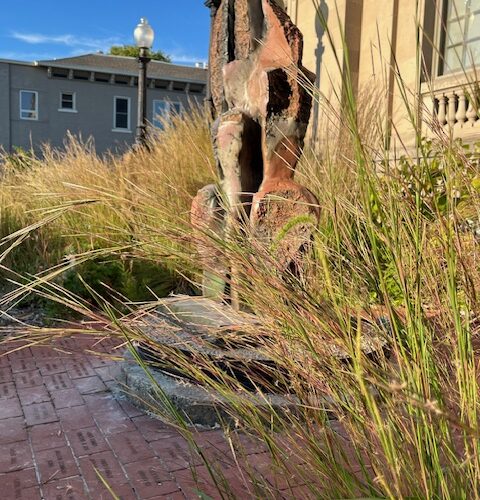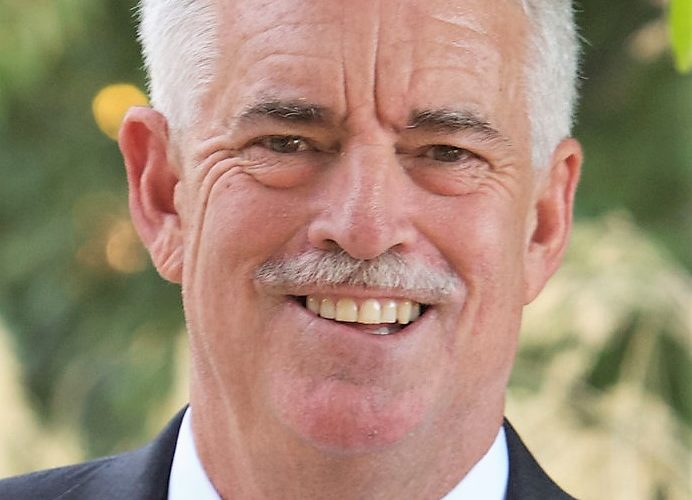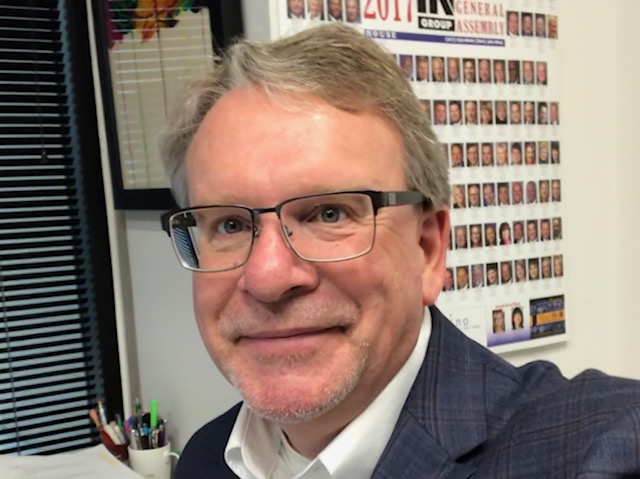HAIKAST XVIII – Fresh Start
I dedicate this podcast to Robert Pulley who has inspired multiple generations of artists in Columbus and beyond as an Arts teacher at Columbus North High School and as a professional sculptor. Mr. Pulley’s work has been featured for over a year in front of the Fresh Start Recovery Center, the building that is the subject of this Haikast. Thank you, Mr. Pulley, for the generous sharing of your craft. It’s a delight to garden around your sculpture. To learn more about Robert Pulley’s work, visit www.robertpulley.com. (NOTE: The photo accompanying this episode includes the Fresh Start sculpture)
Downtown Columbus does not have much greenspace. While there is Mill Race Park on the west side – hugging the river – it is literally across the tracks from downtown. Washington Street, the main street through the heart of downtown, lacks landscaped areas. The most notable flora are the callery pear trees lining the sidewalks for 7 blocks. They are celebrated for their rapid growth and abundant white blooms in early spring. Unfortunately, they smell bad while flowering, drop abundant mushy berries on cars and sidewalks in fall, easily break, and are short lived. And worse, they are an invasive tree species that easily spread to dominate public lands and poorly maintained properties.
Being a native plant advocate, it was a dream of mine to find a place in downtown Columbus to feature a different landscape aesthetic. When approached by Landmark Columbus Foundation in 2020 to do just that, I jumped at the opportunity to write a grant to turn one of the only green spaces downtown into a native plant landscape.
The property is at the corner of 7th and Washington, near the north end of the most heavily trafficked section of downtown. It hosts an old limestone building, over a century old, that was originally the post office. There have been many owners and uses over the years. Most recently, it was converted into the Fresh Start Recovery Center, owned by Volunteers of America, to support women recovering from opioid and other drug addictions. Pregnant women and mothers, along with their young children, are welcome for long term housing as they work towards sobriety.
When I approached staff at Fresh Start, the supervisor immediately had the vision of the project providing opportunities for horticulture therapy for the women staying at the shelter. So after signing a Memorandum of Understanding, acquiring grants, hiring a landscape architect, renting a sod cutter, purchasing plants, and recruiting volunteers, we were ready to transform the turf grass surrounding the beautiful building. On the United Way Day of Caring in May 2021, a TV crew showed up, the volunteers poured in, and the installation was installed within 8 hours. Now butterfly weed, coreopsis, New Jersey tea, spicebush, blue mistflower, columbine, prairie dropseed, and other native plants are thriving.
Native landscapes, while they may appear intimidating to maintain, are actually relatively easy to manage. Native plants have evolved to our local environment over thousands of years, and are an important part of healthy local habitats. In their native region, they are the most sustainable plants, growing deep roots and rarely requiring extra water or fertilizer. And almost all native plants are perennial, meaning that you don’t have to plant them over and over each year by seed or with plugs purchased from a store. After they are established, the primary maintenance is pruning when they get a bit unwieldy and adding mulch to suppress unwanted weeds.
Around the time of the original planting, I helped host a documentary of a film called “5 Seasons” about the landscape architect, Piet Oudolf. He is most well known for the High Line trail in New York City and the Lurie Gardens at Millennium Park in Chicago. Piet is credited for starting the “New Perennial Movement,” focusing on the structure of plants throughout the year – appreciating not just the color of flowers, but also the colors and textures of seeds, stalks, and leaves throughout all seasons. In fact, five seasons refers to planting in the spring and not cutting plants back until the following spring- a nod to appreciating plants for their beauty in all 12 months of the year & acknowledging the ecological value of the plants by not cutting them down after their flowers fade. The seeds, stalks, and leaves are very helpful food and shelter for insects and animals in the fall and winter. The film helped me focus on the entire plant and not just the flower, when considering what it means to be beautiful.
Native plants can take care of themselves in the wild without any human intervention. However, when they are brought into more formal settings – such as being neighbors with prestigious architectural surroundings – they require more maintenance to, shall I say, be more “civilized”. Some native plants may grow to be 8’ tall or higher. Downtown Columbus, known for its famous mid-century architecture, requires a bit more manicured look to be considered attractive.
The maintenance for the native plant landscape at Fresh Start is the responsibility of a combination of community volunteers and the women who live at Fresh Start. In early spring, after not cutting the plants back over winter, it is time to get the pruning shears out. In early March, on a crisp, sunny afternoon, I arrived for the year’s first maintenance job. The women from the shelter were on break outside when I arrived. One of them asked if they could help me out and I gladly welcomed her to join me – in what is always for me – horticulture therapy.
So I gave her the pruning shears, explained what we were doing, and we worked together, with a supervisor from Fresh Start monitoring her work. The woman helping me had recently become a resident at Fresh Start and she spoke constantly throughout the hour that we worked together. I gladly listened and interjected at times when breaking her stream of consciousness seemed appropriate. She was too focused to take up my offer to wear gloves.
She bounced from plant to plant, making quick work out of what was essentially giving a 3 inch from the ground haircut to each plant. She recalled gardening with her grandparents when she was young, her appreciation for flowers, and the peace she felt in the moment. She was presently dealing with addiction and told her supervisor that this could be one of her coping mechanisms. After doing a great job for over an hour, she had to go back inside. Her hands hurt after her enthusiastic work.
While beautifying downtown with a non-traditional landscape was the original goal of the project, witnessing the therapeutic benefits for the women volunteers at Fresh Start is an equally important blessing that the plants provide. It is a reminder that taking care of the plants – as with taking care of the environment – is not a mindless task, but an opportunity for building community connections. I will gladly trade my blood, sweat, and tears for projects like Fresh Start to help beautify areas and build relationships with those who share a passion for lush, colorful, and somewhat wild landscapes.
Bare hands grab grasses
Pruning shears scalp last year’s growth
Eager haste, she bleeds




Recent Comments